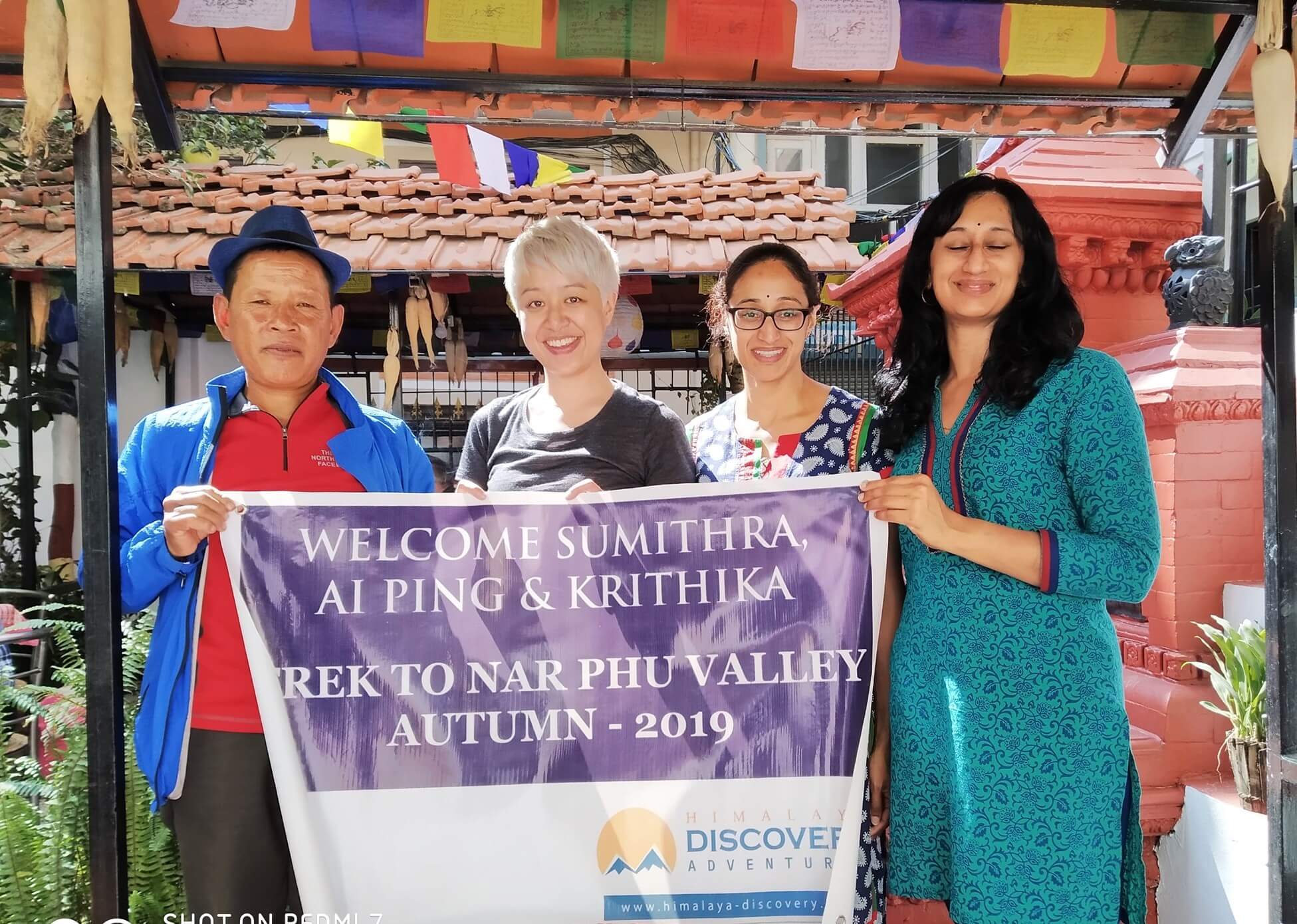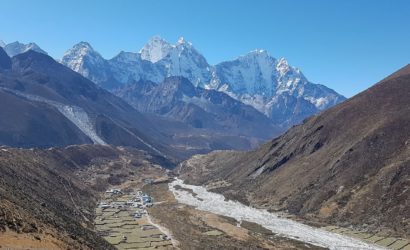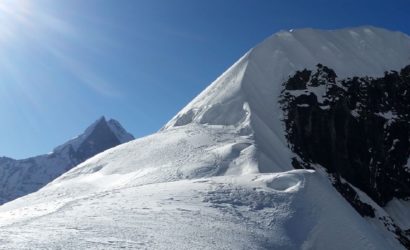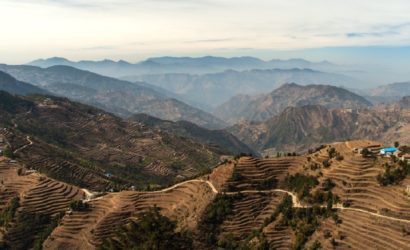The Nar Phu Valley Trek combines high passes and peaks, glaciers, isolated villages, narrow gorges, breathtaking rock formations, yaks, monasteries and unique Tibetan cultures. Nar Phu valley was closed to visitors until late 2003, very few trekkers have discovered these virtually untouched villages.
Beginning at Besisahar: the traditional starting point of the Annapurna Circuit Trek – the trek quickly separates from routes with more foot-traffic and into the Nar Phu valleys.
Passing through colorful Tibetan stupas and prayer wheels into deep canyons, you will get the chance to hang out with local villagers in Phu while they go about their daily life activities, as well as overnight in the Nar Phedi monastery.
These are ultimate ways to learn about life deep in the Himalayas of Nepal. Optionally there is also a hike up to Himlung Himal BC if you’re feeling up to it.
The last few days of the trek take you over the Kang La Pass, and then back to Ngawal, a popular place on the main Annapurna Circuit trek route, so giving you a chance to enjoy home comforts.
Best Time to Trek Nar Phu Valley
This trek is possible both in the monsoon (June-August) and in the two peak tourist seasons (March-May and September-November). The trek is still enjoyable in the monsoon, although the access in the mountains to and from Besisahar could be interrupted by mud and landslides. The high pass could be impassable in winter (December-February) with snow.
Nar Phu Valley Trek Itinerary
This route can be extended by adding a trip to Tilicho Lake and joining the Annapurna Circuit at Yak Kharka. On day 8, instead of trekking from Ngawal to Pisang, continue to Manang, Khangsar, Tilicho Base Camp, Tilicho Lake, Yak Kharka, Thorung Phedi, Muktinath and Jomsom (before returning to Pokhara). The total journey time including the Nar Phu section is 16 days.
The attractions of this variation are the chance to visit the pristine blue waters of the highest lake in Nepal, the pilgrimage temple at Muktinath (holy to both Hindus and Buddhists), and the frontier town of Jomsom, on the edge of Mustang.
Nar Phu Valley Trek Difficulty
This is a challenging trek due to the long days and steep climbs. Due to the limited possibilities of accommodation on the way, there is little flexibility in the distances to be covered every day, therefore the long walking days.
The gains in altitude are pretty steep every day, and how your body reacts to altitude is always unpredictable. So, this trek would be best for those who have a previous hiking experience with good health and fit trekkers.
Accommodation & Meals
A real mix of accommodation can be found on Nar Phu Valley trek. There is a chance in Besisahar to stay in simple but comfortable hotels. Lodge accommodation is generally basic on the trek, as this is not a well-developed walking route.
Accommodation is in the local monastery in Nar Phedi. Food varies from simple but adequate meals in the smaller villages to staple trekker fare in the larger areas, including apple pie!
Nar Phu Valley Trek Permit Costs
The permit costs USD 100 per week, per person from September to November. And it’s USD 75 from December to August.
Arriving at the airport of Kathmandu after completing your custom formalities Visa, etc. Pick up your luggage and look for our Himalaya Discovery Airport Representative who will show your name on the board at the arrival gate. You will be greeted by our representative and transferred by private tourist vehicle to the hotel. Overnight at the Kathmandu hotel.
Today in Kathmandu is free for sightseeing. You may want to visit Durbar Square in the heart of the old town where the old Royal Palace is located with its intricate woodcarving. The entire area is a labyrinth of temples and images.
The narrow alleys leading away from the square in all directions, full of the most amazing variety of shops and stalls. Some of these landmarks are considered World Heritage Sites, including the historic Bhaktapur Durbar Square, the famous’ Monkey Temple ‘ Swayambhunath and the Buddhist Shrine Boudhanath, one of the world’s largest stupas.
There will also be a trip briefing today with gear check. If you need to rent or buy equipment locally, there will be time to do so today. Overnight at the Kathmandu hotel.
Early in the morning drive to Besisahar. After lunch, change to a 4WD drive vehicle for the off-road journey to Koto. The road can be challenging for passengers as for drivers, but this is the most scenic route!
It travels along the old Annapurna Circuit trek route, through amazing gorges and passing stunning waterfalls. Overnight at guesthouse.
Start the day early, because there is plenty of distance to cover. Cross the river and enter the valleys of the Nar and Phu. Towns on the nearby Annapurna Circuit are relatively well developed, but this is not the case in these valleys. Today’s trekking trail passes through beautiful forests, past small cave shelters and pilgrims’ resting places.
The trail emerges from a narrow canyon under a wide waterfall, from which the woods become thinner and the views wider. The last stretch to Meta involves climbing a steep hill from which you can enjoy a wonderful view of some of the giant snowy peaks in the region.
Meta is located on a large open plain and consists of a few simple but clean lodges that offer good food. Overnight at guesthouse.
Trekking out of Meta, some of the unique, colorful Buddhist Tibetan chortens that Nar and Phu are renowned for starting to appear. The trail meanders along the ridge overlooking the magnificent monastery of Nar Phedi, where you will stay in a few days. After another 90 minutes of walking through scenic canyons and gorges, you will reach a monolith guarding the steep path to Phu.
From here you can see the three villages in the area, the old ” dzong ” (Fortress in Tibetan style) and the remains of two ruined forts, impressively situated on the top of the flatlands in front of the village. A line of beautiful chortens colors the landscape just before crossing the bridge to Phu.
After a break and refreshment, take a short walk up to the famous Tashi Lhakhang Gompa to pay tribute to Lama Karma Sonam Rimpoche who came with the Dalai Lama to Nepal in 1959. Overnight at guesthouse.
It’s good to spend an acclimatization day in Phu because of the high altitude. Explore the city’s tiny alleyways or walk to Himlung Himal base camp.
Phu itself is an interesting village, and a day is well spent sitting with the villagers, spinning their yak and sheep’s wool, pounding mustard seeds into a paste for oil or doing their other daily tasks. The walk up to Himlung Himal base camp takes you through a glacial valley for an extra challenge. It’s 7,125m.
Recently peak was opened for climbing. You’ll see herds of blue sheep gently clambering the steep cliffs up the trail. The return journey takes four to five hours. Overnight at guesthouse.
Retrace the route back down to Meta, but turn off at the Nar Phedi Monastery, and Chyakhu will be your overnight accommodation.
Actually, the monastery is all that Nar Phedi is made of! Join them in the kitchen and watch them cook dinner in a small fireplace. They usually do a puja (blessing) at 5 pm, and you are welcome to witness it.
You will be rewarded by the stunning views of Pisang Peak and other surrounding mountain peaks. Overnight at guesthouse.
Today is a very pleasant day. Trekking out of Nar Phedi and follow the winding path to Nar. Pass a line of beautifully painted bamboo chortens on the way to the old town. Arrive around lunch time in the town. Although Nar is not far from the main trail of Annapurna, it is seldom visited by trekkers and is as picturesque as it can be.
Nar is a little more social and lively than Phu, and during the day you can find the square of the village full of chatting women with their looms weaving wool fabric for rugs and blankets. You can stay in a comfortable lodge with an extensive menu with a few new tea houses built in the outskirts of Nar. Overnight at guesthouse.
It’s a long day today, so get up before sunrise and head back to the Kang La Pass, which leads back to the popular trek route Annapurna Circuit. It’s not a hard pass, but it can be a long day, because the effects of altitude are felt.
You can enjoy a wonderful view of Annapurna II, Gangapurna and Tilicho Peak once at the top of the pass. The path begins steeply, but if you enjoy running screens you can have fun! Stop for lunch on a plateau overlooking the summit, then proceed to Ngawal.
Ngawal is certainly very different from the ancient villages that were just visited on the upper Pisang route of the Annapurna circuit. The lodges are large, the menus are much more comprehensive, and most lodges have Wifi and telephone signals. Overnight at guesthouse.
The weather gets much hotter and the greener scenery as you go down from the pass more than 2000 m. Start the last few hours of walking early to reach Pisang.
The trail is wide and comfortable, passing a lovely lake outside Pisang. Stop for a fast snack in the village and drive back to Besisahar by four-wheel drive. Stay in a comfortable hotel there.
The return drive to Kathmandu takes approximately five hours. Enjoy the city’s hot shower and luxuries again! Spend the afternoon shopping in Thamel for souvenirs or simply relax.
Today, you can either stay back and enjoy a free day in Kathmandu or leave for your respective countries.
Our representatives will drop you off at the airport according to your flight schedule.









